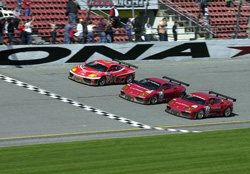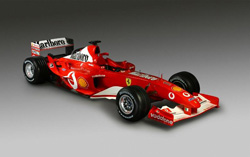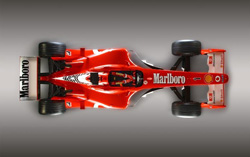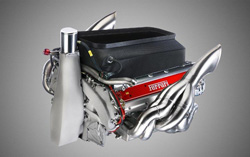
Todt:"...reduction in costs is in the best interests of everyone."
|
2003ís edition of the Rolex 24 Hours at Daytona will go down as one of those odd-ball results. The overall winner was the Racerís Group Porsche GT3 RS in the GT class, outrunning all of the new Daytona prototypes as well as the GT1ís. The privateer Ferraris at this installment did better than in some years past. Giuseppe Risiís team matched their previous best of 2nd overall with the team of Kelleners, Lazzaro, and Mowlem. The team finished 9 laps down because of gearbox issues (long rumored to be the weak point of the 360 GTís), but ran well throughout the race.
A total of five 360 GTís were entered in the race, and three finished the race. The second Ferrari to cross the line was the Ferrari entry driven by Mauro Baldi, Ryan Hampton, Eric van de Poele and Justin Keen which finished eleventh overall and fifth in class, completing 637 laps. Three places and 16 laps behind it was the American JMB Racing team car of Max Papis, Augusto Farfus, Andrea Garbagnati and Emmanuel Collard. The team was hampered by electrical problems and spent more than an hour with the car behind the wall tracking down the gremlin.
Two Ferraris didnít make it to the end. The Ferrari of Washington entry of Wagner, Martini, Tremblay and Wellman only completed 214 laps and was put out after a serious shunt with the wall. The second JMB team car of Earle, Shearer, Manfredi, and Gregoire went out early in its best impersonation of a Maserati Bi-Turbo with huge flames coming out of the engine when Doc Earle was behind the wheel.
Ferrari management actually sent representation in the form of Claudio Berro, head of Ferrariís Corse Clienti program to watch the race. "The 360 GT proved itself to be reliable, the drivers were very consistent in their performance, and the teams worked in a very professional manner, which allowed them to obtain an impressive result, even beating rivals from higher categories. It is a further stimulus to provide our customers with ever more competitive cars." Translation: things will only get better for the privateers. See, things are changing in Maranello. F1 is still the raison d'Ítre, but the customer racers are managing to get more attention. Forza Ferrari!
Daytona International Speedway
3.56-mile road course
Feb. 1-2
1. Buckler/Schrom/Bernhard/Bergmeister, Porsche GT3 RS, 695 laps at 103.012 mph avg. speed;
2. Kelleners/Lazzaro/Mowlem, Ferrari 360GT, 686;
3. Van Overbeck/Steranka/Standridge/Murry, Porsche GT3 RS, 684;
4. Maxwell/Brabham/Empringham, Ford Multimatic, 679;
5. Haywood/France/Goodyear/Sharp, Porsche Fabcar, 661;
Ferrari).
Ferrari Unveils 2003 F1

Todt:"...reduction in costs is in the best interests of everyone."
|
February 7, 2003 Maranello.
Ferrari unveiled its 49th single seater to compete in the 2003 FIA F1 Championship on Maranello. Yet another twist comes out for Ferraristi to try and keep up with. The F2003-GA is self explanatory. The GA is out of honor to the late Giovanni Agnelli.
The construction of the car picks up where the F2002 left off, but you donít have to take my word for it. Here is what Rory Byrne had to say about it in the press conference.
1. Aerodynamics
The side pods, radiator layout, and inboard rear suspension are fundamentally new. This has enabled us to make a step forward both in terms of aerodynamic performance and cooling efficiency and we have several development items including front wing, turning vanes, brake ducts, and revised rear suspension components which we plan to introduce into the test program in the next 3 to 4 weeks which will further enhance performance.
2. Transmission
Although the transmission is essentially a development of the F2002 transmission, it is considerably shorter, narrower and lighter. The gears have been redesigned to save weight and improve durability, and the gear selection system has been further refined for a faster gearshift. We have also taken another step in terms of engine, transmission, rear suspension integration.
3. Suspension and Steering
The power steering system has been fundamentally redesigned. A prototype version has been successfully tested on the F2002. Closer cooperation with Bridgestone has resulted in an improved understanding of the interaction

Todt:"...reduction in costs is in the best interests of everyone."
|
between tire and car and has enabled us to revise the suspension to maximize the performance of the Bridgestone tires. Both front and rear suspension have been revised to maximize the performance of the Bridgestone tires. The inboard end of the rear suspension has been completely revised and includes a new damper system. Almost all of the suspension components have been refined and many have been manufactured using new materials and manufacturing methods in order to reduce weight.
4. Electronics
The new Marelli Step10 electronic system has been incorporated which, with its superior processing speed and power, will give us improved control of the engine and the gearbox, as well as better data acquisition. The system has been developed and tested in a F2002 for the last 6 months.
Paolo Martinelli, the architect of the engine, had this to say about the new creation.

Todt:"...reduction in costs is in the best interests of everyone."
|
"The new V configuration 10 cylinder F1 engine for the 2003 Championship is an evolution of technological experience, combined with the technical abilities of the Ferrari engine specialists. Its code name is 052.
Its starting point is an evolution of our 051 engine: but it is completely new, from top to bottom, and all its parts will be developed right through to the penultimate Sunday in October to reach our targets in the 2003 Championship.
The 052 engine project has two specific technical aims:
1. improving performance and usability, while maintaining the requisite reliability demonstrated by its predecessor, the 051.
2. very close integration with the car design, with the final development resulting in a reduction in weight (of the order of between 4 and 5%,) the lowering of the roll-centre, and a new layout of the engine ancillaries and the cooling and lubrication systems.
The engine project was carried out and evolved alongside that of the car in a completely integrated fashion: the 052 can only be fitted to the new F2003-GA car.
Architectural characteristics: the engine block is completely new and manufactured by microfusion, the heads are lowered, all in an evolution of the structures used in the final B version of the 051. The engine features innovative materials where applicable for various functions. One specific evolution is in the area of fuel and engine oil, carried out with the invaluable support of Shell. In terms of performance, development will be continuous with evolutionary steps already planned into the program. Maximum engine revs at the start of the season will be around 200 rpm higher than that on the 051.
As usual, we will not disclose a horsepower figure, but rest assured, that once again this year, all the Ferrari engine specialists will work in methodical and determined fashion to provide "sufficient" horsepower, delivered in a "useable" and "reliable" fashion to reach our goals in the F1 championship."
Needless to say, after the success that the team achieved with the F2002, if the feeling is that the new one is better, other teams are really going to have an upset stomach going into the season opener at Melbourne on March 9th.
Technical Specifications
Model: F2003-GA
Engine: 3000 Ferrari (Type 052), V10
Total Displacement: 2,997 cm3
Timing Gear: 40 valves
Fuel Feed: Magneti Marelli digital electronic injection
Ignition: Magneti Marelli static electronic ignition
Transmission: Semiautomatic sequential electronically controlled gearbox, limited-slip differential, 7 gears + reverse
Chassis: Carbon-fibre and honeycomb composite structure
Front Suspension: Independent suspension, push-rod activated torsion springs
Rear Suspension: Independent suspension, push-rod activated torsion springs
Brakes: Ventilated carbon-fibre disc brakes
Length: 4,545 mm
Width: 1,796 mm
Height: 959 mm
Front Track: 1,470 mm
Rear Track: 1,405 mm
Curb Weight (with water and oil): 600Kg
Wheels: 13"



